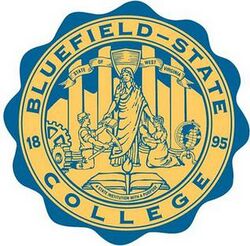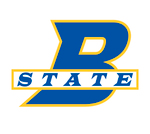Bluefield State College
Topic: Organization
 From HandWiki - Reading time: 8 min
From HandWiki - Reading time: 8 min
 | |
| Motto | Making Education Possible |
|---|---|
| Type | Public, HBCU |
| Established | 1895 |
| President | Robin C. Capehart |
| Students | 1,246[1] |
| Location | Bluefield , West Virginia , United States |
| Campus | Bluefield (main campus), Beckley, Lewisburg, Summersville and Welch, West Virginia |
| |u}}rs | Royal blue & gold |
| Athletics | NCAA Division II |
| Nickname | Big Blues |
| Mascot | Big Blue |
| Website | www.bluefieldstate.edu |
 | |
Bluefield State College is a historically black college in Bluefield, West Virginia. It is a part of West Virginia's public education system and offers baccalaureate and associate degrees. It is the only non-residential four-year college in the state system. Bluefield State College is a member school of the Thurgood Marshall College Fund. Even though it maintains its federal status as a historically black college, the student body at Bluefield State College is less than 13% black and over 80% white.[2]
History
| Bluefield Colored Institute | 1895–1932 |
| Bluefield State Teachers College | 1932–1943 |
| Bluefield State College | 1943–present |
The Bluefield Colored Institute was founded in 1895 as a "high graded school" for African-American youth in the nearby area;[3] at that time, the West Virginia Constitution prohibited "racial" integration in publicly-supported schools, and until 1891, when West Virginia Colored Institute was founded, there was no education at the college level for African Americans in West Virginia (except at the private Storer College). It was located on a 4-acre (0.016 km2) site in Bluefield, a city within 100 miles of 70% of West Virginia's Black citizens. The school began with 40 pupils under the supervision of Principal Hamilton Hatter. Nathan Cook Brackett, an abolitionist who led Storer College, served as president of the Board of Regents.[4] Hatter oversaw the construction of Mahood Hall, the administrative building, as well as Lewis Hall and West Hall dormitories. Hatter built the foundation of the College. He faced enormous challenges, running the institution with no legislative appropriations whatsoever for two years.[citation needed]
In the late 1920s, the students and staff of the school referred to it as "Bluefield Institute", but this name was never sanctioned by the West Virginia legislature. In 1906, Hatter handed the reins of leadership at BCI to Robert P. Sims, a graduate of Hillsdale College, who would lead Bluefield State for three decades. Sims showed dedication, commitment, and prudent management in his lengthy tenure at Bluefield State.[citation needed] In 1909, Sims established Bluefield as a normal school, training teachers.
Enrollment climbed to 235 by 1920, with annual summer sessions for teacher certification attracting hundreds more. The College prospered, expanding to 23 acres, adding Payne Hall and colonnaded Conley Hall, faculty residences, and the stately President's House. Enrollment soon exceeded six hundred, many of whom lived on the close-knit campus, termed the "terraced hills" for its verdant landscaping. Grateful graduates created the Alumni Association to rekindle collegiate memories and support programs of the institution. Bluefield students achieved notable distinction in a wide variety of fields.[citation needed]
Sims and his successor, academic dean and BCI alumnus Henry Dickason, president from 1936 to 1952, managed this growth with patience and resourcefulness.[citation needed] Bluefield State Teachers College, as the institution was renamed in 1931, was at the center of the rich cultural world of African-American society. Although the rough and tumble bituminous coalfields were far from the urban and sophisticated east coast, Sims and Dickason managed to involve their college heavily in the explosion of black American culture known as the "Harlem Renaissance," bringing Langston Hughes to read poetry, John Hope Franklin to teach Negro History, and even heavyweight champion Joe Louis to box exhibitions in Arter Gymnasium. Fats Waller, Duke Ellington, Dizzie Gillespie, and Count Basie entertained the active Greek-letter fraternities and sororities. Bluefield State's "Big Blue" football team twice won national Negro College Athletic Association championships in the late 1920s.[citation needed][dubious ]
A 1929 survey of the 702 alumni of Bluefield State demonstrated the college's wide-ranging influence. There were 326 school teachers, along with dozens of administrators, physicians, pharmacists, ministers, businessmen, and homemakers. The name "Bluefield State College" was adopted in 1943. After a half-century Bluefield State was awarded full academic accreditation in 1947, rewarding the institution's measured progress. By September 1954, the state-supported colleges in West Virginia were integrated. Three white students (James Ernest Watkins, Joseph Tice and Douglas Ralph Whittaker) in a total body of 354 enrolled at Bluefield State.
By the 1960s, the College had a comprehensive four-year program of teacher education, arts and sciences, and engineering technology. Gradually a variety of two-year technical programs evolved in response to local needs.
During the late 1960s, black students protested that the state was transforming the school from a traditional black college to a white commuter college. One of the allegations made was that black faculty and staff were being fired and replaced by less qualified white personnel.[citation needed] On November 21, 1968, the racial tensions culminated in the bombing of the gymnasium. A $5,000 reward was offered by Governor Hulett C. Smith. Ironically, the administration responded by immediately closing the dormitories, which housed a significant percentage of the college's out-of-state black student population, hastening the transition to a predominantly white college.[5]
The Alpha House and President's House, Bluefield State College (now named The "Hatter" House) are listed on the National Register of Historic Places.[6]
In 2003, the school's two-year programs, except for those in nursing and engineering technology, were separated out to form New River Community and Technical College.[7]
Academics
| Category | Percent |
|---|---|
| White | 84.77% |
| Black | 8.41% |
| Hispanic | 1.31% |
| Asian | 0.87% |
Instructional programs are offered in engineering technologies, business, teacher education, arts and sciences, nursing and health science professions, and a variety of career fields. Students may also complete the non-traditional Regents Bachelor of Arts degree through Bluefield State College. The college is also dedicated to offering a wide variety of off campus courses at centers in Beckley, Lewisburg, Summersville and Welch, West Virginia.
(As of 2017), Bluefield's student body is 63.31% female and 36.69% male.[8] Although Bluefield is a historically black college, its student body has the racial composition listed in the table.
Student life
Athletics
Bluefield State's athletic teams, known as the Big Blue, compete in NCAA's Division II as a member of the United States Collegiate Athletic Association. They were a member of the West Virginia Intercollegiate Athletic Conference until the conference's dissolution, then went independent until being granted membership into the ECAC. Their sponsored sports are men's and women's basketball, baseball, softball, tennis and cross-country, men's golf and wrestling, and women's volleyball.
The college fielded a football team until 1981. In 1927 and 1928, Bluefield State was voted the Black college football national champion by the Pittsburgh Courier. Ray Kemp was the team's coach for an extended period of time beginning in 1934. Joe Fourqurean played professionally for the British Columbia Lions of the Canadian Football League.
On August 2020, Bluefield State announced the addition of 12 athletic programs, which includes the resurrection of the football program. School President Robin Capeheart called it a huge step forward and it was saying there was life after COVID-19. The teams are set to start for the 2021-22 season.[9]
There are also several intramural sports including swimming, mixed martial arts, soccer, bowling and flag football.
Greek life
Bluefield State College currently has Alpha Kappa Alpha Sorority as the only African American sorority on Campus.
Notable alumni
References
Notes
- ↑ As of fall 2019. "Enrollment". West Virginia Higher Education Policy Commission. http://www.wvhepc.edu/resources/data-and-publication-center/data-center-enrollment/.
- ↑ Meraji, Shereen Marisol; Gene Demby (October 18, 2013). "The Whitest Historically Black College In America". NPR. https://www.npr.org/blogs/codeswitch/2013/10/18/236345546/the-whitest-historically-black-college-in-america.
- ↑ Ambler, Charles H. (1951). A History of Education in West Virginia: From Early Colonial Times to 1949. Huntington, W.V.: Standard Printing & Publishing Company.
- ↑ Brackett, H.I., Brackett Genealogy: Descendants of Anthony Brackett of Portsmouth and Captain Richard Brackett of Braintree. With Biographies of the Immigrant Fathers, Their Sons, and Others of Their Posterity pt. 1 (1907) pg. 151-152 https://books.google.com/books?id=EDk3AAAAMAAJ
- ↑ "The Whitest Historically Black College In America". NPR.org. 18 October 2013. https://www.npr.org/blogs/codeswitch/2013/10/18/236345546/the-whitest-historically-black-college-in-america.
- ↑ "National Register Information System". National Register of Historic Places. National Park Service. July 9, 2010. https://npgallery.nps.gov/NRHP.
- ↑ New River Community and Technical College. "College History…". http://www.nrctc.edu/index.php?option=com_content&task=view&id=17&Itemid=32.
- ↑ 8.0 8.1 Pastel, Ralph (October 15, 2009). "STUDENT PROFILE ANALYSIS FALL 2009 CENSUS". BLUEFIELD STATE COLLEGE. p. 2. http://www.bluefieldstate.edu/IRE/Documents/Fall%202009%20Student%20Census%20Profile.pdf.
- ↑ "Bluefield State Returns Football And 11 Additional Sports For 2021-2022". https://bluefieldstate.edu/community/news-and-events/bluefield-state-returns-football-and-11-additional-sports-2021-2022.
Further reading
- Meraji, Shereen Marisol; Demby, Gene (October 18, 2013). "The Whitest Historically Black College In America". Morning Edition. NPR. Retrieved October 19, 2013.
External links
[ ⚑ ] 37°15′54″N 81°14′24″W / 37.265°N 81.24°W
 KSF
KSF
